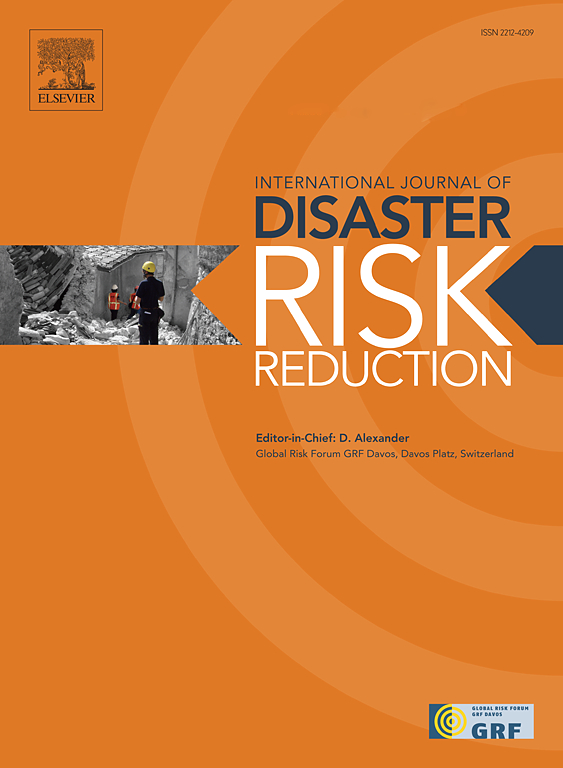Community resilience to socio-environmental disasters in Itajaí Valley, Brazil
IF 4.2
1区 地球科学
Q1 GEOSCIENCES, MULTIDISCIPLINARY
International journal of disaster risk reduction
Pub Date : 2024-09-19
DOI:10.1016/j.ijdrr.2024.104828
引用次数: 0
Abstract
The Itajaí Valley (Brazil) is historically hit by disasters characterized by landslides and floods. Despite some level of preparedness, the changing rainfall regimes which became less predictable and more severe, is exacerbated by uncertainties of climate change challenging the state of resilience in the area. Community perception in disaster risk areas is one of the key components for identifying the state of resilience to disasters. Hence, to better understand the nature of changing resilience, this research aims to identify and compare the state of resilience of communities (SC) in the Itajaí Valley by analyzing risk perception of local communities. A descriptive-evaluative methodology is used through a quantitative survey approach in the at-risk areas in two distinct phases. Data collection in the first phase took place between March and July 2023, a period temporally distant from the last major disaster, which occurred in 2008. The second phase of data collection took place between the floods of October and November 2023. The results of the research indicate that exposure to the October 2023 floods had a substantial impact on the population's perception of risk, in which changes were observed in all the aspects of community resilience analyzed. In this sense, there was a significant increase in resilience during the reorganization phase, strengthening the consensus with studies related to adaptive cycles. The results enable a more precise understanding of vulnerable areas, allowing decision-makers to pinpoint where resources and efforts should be directed with greater accuracy.
巴西伊塔雅伊谷社区抵御社会环境灾害的能力
伊塔雅伊河谷(巴西)历来遭受以山体滑坡和洪水为特征的灾害。尽管该地区已经做好了一定程度的防灾准备,但由于降雨机制不断变化,可预测性降低,降雨量增加,气候变化的不确定性加剧了该地区的抗灾能力。灾害风险地区的社区观念是确定抗灾能力的关键因素之一。因此,为了更好地了解抗灾能力变化的本质,本研究旨在通过分析当地社区的风险意识,确定并比较伊塔雅伊河谷社区(SC)的抗灾能力状况。本研究采用描述性评价方法,通过定量调查的方式,分两个不同阶段对高风险地区进行研究。第一阶段的数据收集工作在 2023 年 3 月至 7 月期间进行,这段时间与 2008 年发生的上一次重大灾害在时间上相距甚远。第二阶段的数据收集在 2023 年 10 月至 11 月的洪水期间进行。研究结果表明,2023 年 10 月的洪灾对居民的风险意识产生了重大影响,在分析的社区抗灾能力的所有方面都观察到了变化。从这个意义上讲,重组阶段的复原力显著增强,加强了与适应周期相关研究的共识。研究结果有助于更准确地了解脆弱地区,使决策者能够更准确地确定资源和努力的方向。
本文章由计算机程序翻译,如有差异,请以英文原文为准。
求助全文
约1分钟内获得全文
求助全文
来源期刊

International journal of disaster risk reduction
GEOSCIENCES, MULTIDISCIPLINARYMETEOROLOGY-METEOROLOGY & ATMOSPHERIC SCIENCES
CiteScore
8.70
自引率
18.00%
发文量
688
审稿时长
79 days
期刊介绍:
The International Journal of Disaster Risk Reduction (IJDRR) is the journal for researchers, policymakers and practitioners across diverse disciplines: earth sciences and their implications; environmental sciences; engineering; urban studies; geography; and the social sciences. IJDRR publishes fundamental and applied research, critical reviews, policy papers and case studies with a particular focus on multi-disciplinary research that aims to reduce the impact of natural, technological, social and intentional disasters. IJDRR stimulates exchange of ideas and knowledge transfer on disaster research, mitigation, adaptation, prevention and risk reduction at all geographical scales: local, national and international.
Key topics:-
-multifaceted disaster and cascading disasters
-the development of disaster risk reduction strategies and techniques
-discussion and development of effective warning and educational systems for risk management at all levels
-disasters associated with climate change
-vulnerability analysis and vulnerability trends
-emerging risks
-resilience against disasters.
The journal particularly encourages papers that approach risk from a multi-disciplinary perspective.
 求助内容:
求助内容: 应助结果提醒方式:
应助结果提醒方式:


